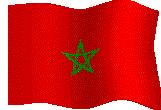 |
3 Mar: Rabat - Morocco's Graceful Capital |
 |
3 Mar: Rabat - Morocco's Graceful Capital |
An Under-rated Place
Woke up early again. Took the 7 am bus to Rabat, capital of Morocco, and another great imperial city in history. It was a foggy morning and despite that, the driver drove through the mountain road as though he's late for a flight. Soon we left the beautiful Rif and were down to the flat coastal plains of western Morocco. This must be the rice-bowl of Morocco - vegetables, rice and wheat everywhere. The traffic became increasingly heavier as well. After all, most of Morocco's population live in this coastal plain.
The bus passed Sale, Rabat's twin city across the Bou Regreg River, and then proceeded to the Central Bus Station. It was about 12 noon when I finally reached there. I checked into Hotel Majestic located at the boundary of Ville Nouvelle with the Medina - great location with lots of cheap eats around. The Hotel has been newly renovated and it now looks like a smart business hotel with English-speaking staff who knows how to use the computer. The price had more than doubled compared to LP's, but it was very good value at about US$30. As usual, I dumped my bags quickly and proceeded to walk to Tour Hassan (Hassan Tower), Rabat's grandest monument.
Rabat was first founded by the Romans, whose ruins, known as Sala Colonia, is a minor attraction along the Bou Regreg today. It soon faded into obscurity and popped out occasionally as a minor provincial outpost of various dynasties such as the Idrissids and the Almoravids. It was during the reign of the Almohad Caliph, Yacoub al-Mansour (the Victorious), that Rabat first became an imperial centre. After he won major victories in Spain and crushed rebellions in Tunisia, he decided to build a new capital, Ribat al-Fatah, or Victory Fortress. Grand projects were undertaken in Rabat, the most famous of which was supposed to be the greatest mosque in the Islamic world. His ambitions did not materialise, for work was stopped after his death in 1199. The only part of the Hassan Mosque completed was the grand minaret, now known as the Hassan Tower (or Tour Hassan in French).
Rabat soon faded into history but emerged again in the 17th century as a pirate republic. The Republic of Bou Regreg, which comprised the originally rival cities of Rabat and Sale, soon stroke fear among European sailors. The Republic was out to capture the rich booty of the Americas, which were harvested with great cruelty by Spanish and Portuguese conquistadors. This, together with European slaves and the wealth of inland caravan trade, made Rabat a wealthy country. This state of affairs did not last forever, for their activities were soon restricted by the arrival of the Alawite Dynasty and the subsequent French occupation. The French put Rabat on the political map again by moving the administrative capital from Fes to Rabat, where the French army and civil service could be supplied with greater ease. After independence in 1956, Rabat remains the national capital.
Rabat's Ville Nouvelle is a city of wide boulevards and grand buildings - the French surely know how to build capital cities. It is also cosmopolitan - and seems that many more people speak English here than elsewhere in Morocco. This is the city for big government and diplomacy. Therefore, people here probably also realise that English is the only real international language of the post-WWII world. Because it is not the commercial capital (Casablanca), people are also more laid-back, confident and friendly. Rabat doesn't depend on tourism for a living and so there are few touts and little over-charging of tourists so prevailing elsewhere in Morocco. I like this city.
Tour Hassan is located along the banks of Bou Regreg River. The
tower itself was impressive. At 44 feet, it rose above all other
buildings in the surrounding areas. The carvings on it were very
intricate and I wished it was possible to get up there. Within the
complex was the tomb of Muhammed V, father of the current king, and fighter
for national independence against the French. His mausoleum is a
nice building with a bright green roof. Soldiers stood on guard in
their magnificent traditional red robes. Some were even on horses
- all could have looked like the aggressive warriors of the various Moorish
empires that overran Iberia. However, unlike ceremonial guards elsewhere
in the world, these soldiers do not appear to be as proud of their role.
Instead of standing straight at attention, most of them appeared miserably
bored and uncomfortable. Some were chatting with each other, while
a few were leaning against the wall. In some countries, such behaviour
may be subjected to court martial…
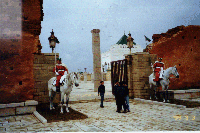 |
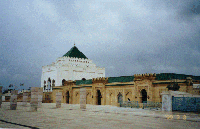 |
|
|
|
Bou Regreg separates Rabat from Sale. Mediaeval city walls surround Sale on the northern side of the river, and at the river mouth is the Kasbah des Oudaias, a dominating fortress that guards the imperial cities from maritime threats. Along the river are sandy beaches where Rabat's citizens enjoy watersports on this public holiday, Feast Of The Throne, the fanciful name for His Majesty's coronation anniversary day. Waterbirds gathered in their hundreds in a short unaccessible stretch of beach squeezed between Oudaias and a club house - what an innovative way of conserving wildlife !
Oudaias is another World Heritage site. Built in 1195 by the Almohads,
this is a city within a city. It's full of little alleys and houses
where people still live. Unfortunately, the museum was closed and
so I decided to spend some time at a café overlooking the estuary.
I had mint tea there for a while, admiring the panoramic view. I
pondered over my plans. I have been well ahead of my original plan.
I am tempted to stick by my original plan to spend more time in Rabat.
But I also recalled many people telling me about the excitement of Essaouira,
not to mention my weakness for World Heritage sites - both Essaouira and
El Jadida nearby hold such honours. OK, I shall leave Rabat tomorrow
for El Jadida and Essaouira. I don't think I will visit the National
Archaeology Museum - it's probably like museums elsewhere in Morocco, with
nothing but Arabic and French captions. I would rather explore other
parts of the country.
Dreams
Behind Oudaias is a lighthouse and a very rocky, treacherous shoreline, a great contrast to the soft sand that line the river banks not far away. Tumultuous waves beat the rocks while seabirds screamed from above. Sitting on a rock, I could imagine the powerful Portuguese fleet attacking local fishing boats, and then landing, laying waste to the countryside. Then the pirate fleet of Bou Regreg appeared, attacking a lone conquistador ship laden with treasures of the Americas. And I saw the French gunboats bombing the Moroccans - has the world really changed ? Portuguese man-of-war, Bou Regreg pirate ships, French gunboats, and American fighters that now fly over Iraqi airspace and bomb the country on a regular basis - has anything changed at all ? It's no different from the basic rules of survival - the fittest survives - the big fish eats small fish, and the small fish devours shrimps.
My peace was interrupted by someone shouting in Japanese a few meters away. "Konichiwa," a Moroccan greeted me in Japanese from his primitive shed twenty meters away. He went on speaking Japanese while I walked towards him.
"Salaam aleykum. Me, non-Japonnaise," I said in a grammatically atrocious mixture of Arabic, English and pseudo-French. [Apologies to any French who read this passage.] "Non parle Japonnaise."
He was disappointed and returned to his pathetic shed, though seemed
a little pleased that I had used some Arabic. Just a hundred meters
away were luxury apartment blocks. How life differ within such short
distances ! I turned round and found my view was blocked by a huge
banner celebrating the festive day.
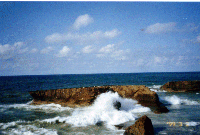 |
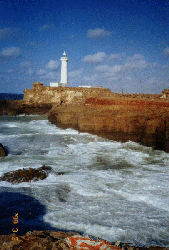 |
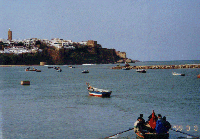 |
|
|
|
|
I returned to the vicinity of Hotel Majestic and strolled along the graceful Avenue Mohammed V with its palm trees and Franco-Moorish architecture - the most important streets in every Moroccan city are named after the king or his father. The boulevards were crowded with shoppers and families on outings. Cafes were overfilled with people. Huge banners celebrating the king's reign hung everywhere. Television programmes were full of the king's wise speeches, highly informative and educational documentaries about the king's life, and even great entertainment fare such as poetry recital competition in praise of the king.
I walked into the outer grounds of the Royal Palace, had interesting small talk with the friendly soldiers. Heavy military garrisons surround the king's palace - not a surprise considering the number of coup and assassination attempts against the king in the past few decades. In one particular attempt, the king's plane was attacked and hit by rebel fighter planes. His quick-wit pilot promptly congratulated the rebels for the king's death and they allowed the plane to land safely. The king survived and the rebellion was crushed. This is what Moroccans call baraka, or good grace from heaven.
Nearby is the Chellah, the old ruins of Sala Colonia over which the Merenids built a fortress. Here, Islamic minarets and tombs rose above the foundations of the Roman settlement. Storks made their home here, oblivious of all activities around them. It was an amazing sight. This is the edge of the city, for one could see the agricultural fields across the river, and to the northwest, the lights of Sale and Rabat brightened the skies. Rabat is indeed a beautiful city, and yet there is little publicity about it. A truly under-rated city.
![]() 4 Mar: Rabat - El Jadida - Essaouira
4 Mar: Rabat - El Jadida - Essaouira